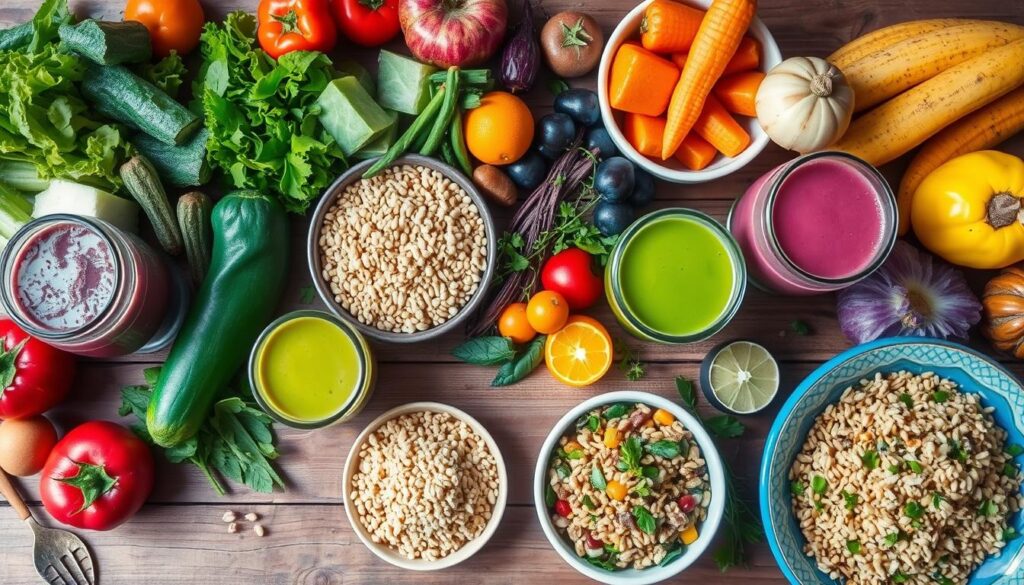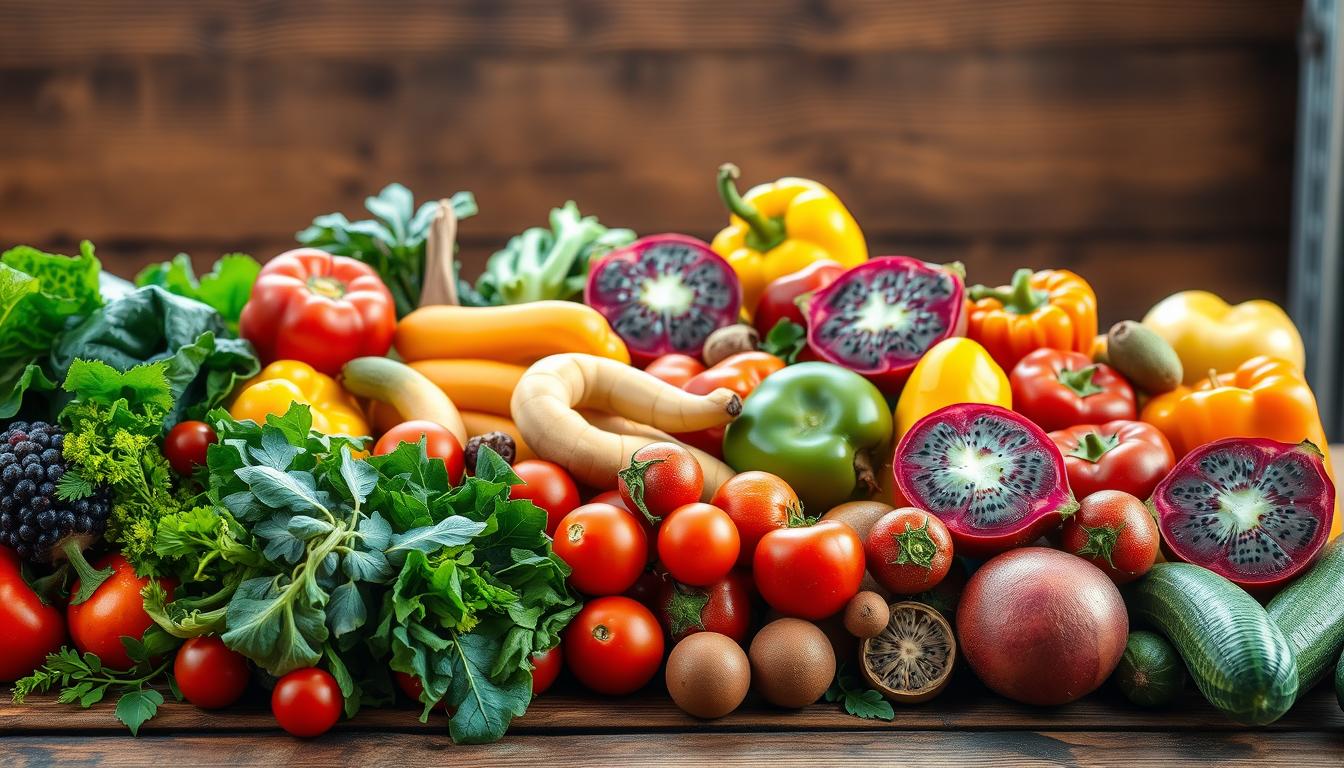What to Eat: Healthy Food Guide for Every Lifestyle
“Let food be thy medicine and medicine be thy food.” – Hippocrates. This advice shows how important what we eat is for our health.
Starting a healthy eating journey means making easy, lasting changes. It’s about seeing food as a source of nourishment and happiness, not just calories. We should focus on eating a variety of foods that are good for us and eat less of processed foods.
What we choose to eat can greatly affect our health. Studies show that eating too much processed food can lead to serious health issues like cancer and heart disease1. On the other hand, eating mostly whole, nutritious foods can help us live longer and stay healthier1.
It’s also important to remember that everyone’s diet is different. This is because of many factors like where we live, how much money we have, our culture, and what we like to eat. So, whether you want to lose weight, have more energy, or just feel good, knowing what to eat is crucial for making healthy choices and eating well.
Table of Contents
Why Healthy Eating Matters
Eating healthy is key to fueling your body with the nutrients it needs. A diet rich in nutrients can lower the risk of diseases like type-2 diabetes and heart disease. It also helps you live longer.
Good food also boosts your mental health. It can help prevent depression, especially for those who are less active. Switching to whole foods can greatly improve your health and prevent diseases in the long run.
Physical Health Benefits
Food rich in vitamins and minerals is essential for your body. Lack of vitamins A, B, C, and E, and minerals like zinc and iron, weakens your immune system2. Foods high in fiber can lower cholesterol and heart disease risk, as the American Heart Association says3 and4.
Eating less saturated fat and more fiber from whole grains can also prevent type-2 diabetes2.https://www.naturalpurecare.com/selenite-crystal/
Mental Health Benefits
Good nutrition is also crucial for your mind. The Mediterranean diet, for example, has been linked to better mental health in a 2020 study3. Foods rich in B vitamins, iron, and polyphenols support brain health, helping with stress and mood3.
Eating more fruits, vegetables, and whole grains can also boost your mental health by supporting good gut bacteria3.
Long-term Disease Prevention
Planning your diet well can help prevent diseases in the long run. Foods like vegetables, fruits, and beans are low in calories and can help manage weight. This reduces the risk of heart disease and type 2 diabetes3.
The DASH diet promotes a balanced intake of potassium, magnesium, and calcium to control blood pressure and prevent heart disease3. Reducing sodium intake, as the DASH diet suggests, also lowers heart disease risk3. Maintaining a healthy weight through balanced nutrition can also lower cancer risks linked to obesity3.
Understanding Nutrient Density
Knowing about nutrient density is key when choosing what to eat. Foods high in nutrient density give you lots of vitamins and minerals without too many calories.
What is Nutrient Density?
Nutrient density shows how much nutrition a food has compared to its calories. For example, kale is packed with vitamins C, A, K, and B6, and minerals like potassium and calcium. It only has 9 calories per cup5. Eating nutrient-dense foods means you get more nutrition for your calories.
Examples of Nutrient-Dense Foods
Eating nutrient-dense foods helps you get important nutrients without extra calories. Wild Atlantic salmon, for example, has lots of omega-3s and high-quality protein5. Grass-fed beef from Tyner Pond Farm is also full of nutrients like omega-3s and vitamin B126.
Choosing fresh foods like strawberries over jam means you get more nutrients and less sugar7.
Importance of Macronutrient Balance
It’s important to balance your macronutrients—carbs, proteins, and fats—to stay healthy. Beef liver, for instance, is rich in vitamin B12 and iron, helping with protein intake5. Healthy fats from grass-fed beef boost energy and lower inflammation6.
Foods like bitter melon add fiber, calcium, and vitamins without too many calories5.
What to Eat for Varied Diets
Having a diverse diet is key for good health and managing weight. It helps your body get all the nutrients it needs. Let’s look at why diet diversity is important and how to make a balanced plate.
Importance of Diet Diversity
Diet diversity is vital for a healthy gut, weight management, and overall well-being. Eating a variety of foods supports longevity and prevents chronic diseases. Research shows that healthy eating can lead to a longer life and lower risks of serious health problems like heart disease and obesity8.
Try to eat foods from all major groups. Focus on natural, nutritious, or lightly processed items. This approach ensures you get all the nutrients your body needs.
Building a Balanced Plate
Making a balanced plate is crucial for healthy eating. It should have different food types for proteins, fats, and carbs. The Dietary Guidelines for Americans 2020–2025 suggest focusing on fruits, vegetables, whole grains, and low-fat dairy8.
Include a variety of protein sources like seafood, lean meats, eggs, legumes, and nuts8. If you’re new to diverse eating, start with one new food at a time. Gradually add more to your diet.
Healthy eating means less added sugars, sodium, and unhealthy fats. Stay within your daily calorie limit. A balanced lifestyle with exercise and nutritious foods is essential for long-term health8.
Healthy Food Choices for Different Lifestyles
You can make healthy food choices no matter your lifestyle. Whether you’re busy or on a tight budget, diet planning is key. Focus on quick, nutritious recipes that support your health.
Diet Planning for Busy Lifestyles
If you’re always on the go, planning your diet is essential. Studies show adding high-quality protein to your meals is important, especially as you get older9. You can get enough protein from plant-based sources every day9.
Meal prepping is a great strategy. Set aside a few hours each week to prepare meals. Try making simple dishes like grilled chicken salads or quinoa bowls ahead of time. This way, you’ll always have healthy meals ready.
Don’t forget to include omega-3 fats in your diet. They’re vital for your physical and mental health9. Snacks like nuts and seeds are easy to grab and go, providing a boost of these fats.
Whole grains and vegetables are also important. They give you lasting energy without causing blood sugar spikes9.
Nutritional Meals on a Budget
You don’t have to spend a lot to eat healthy. By planning your diet and choosing ingredients wisely, you can save money. Buying in bulk, like grains and beans, is affordable and versatile.
Focus on seasonal produce to save money and get fresher, more nutritious food10.
Making smart substitutions can also help keep your diet affordable and nutritious. For example, a homemade burrito with chicken, veggies, and salsa is under 750 calories. But a restaurant version can be over 1,000 calories11.
Follow MyPlate’s guidelines for a balanced diet: eat at least 2 cups of fruit, 2½ cups of vegetables, 6 ounces of grains, 5½ ounces of protein, and 3 cups of dairy daily10. This ensures you get all the nutrients you need while staying within your budget.
Lastly, watch your portion sizes. Aim for meat, fish, or chicken the size of a deck of cards, and half a cup of sides like rice or pasta, the size of a light bulb9. This helps manage both cost and nutrition.
Meal Ideas to Kickstart Your Day
Starting your day with a nutritious breakfast, lunch, and dinner is key. These meal ideas offer delicious and nourishing options. They help keep you energized all day long.
Nutritious Breakfast Options
A nutrient-packed breakfast is vital for a great start. Chia seed pudding is easy to make and full of fiber, omega-3s, and antioxidants. There are over 41 breakfast ideas, using ingredients like oat flour, avocados, and Greek yogurt1213.
Savory breakfast muffins are great for any diet. Quick options like protein bars and nut butter on toast with fruits are also good14. Skipping breakfast is common, so having a plan helps keep a morning routine14.
Quick and Healthy Lunches
Lunch needs to be quick and healthy. Try a Protein-Packed Turkey BLT Salad for a nutritious meal12. Whole-grain wraps with fresh veggies are also fast and healthy.
There are 35 Easy Chicken Recipes that can be made in 15 minutes. Use ingredients like cherry tomatoes and smoked salmon for a balanced meal12.
Balanced Dinner Recipes
Ending your day with a balanced dinner is important. Choose lean proteins like grilled fish or tofu with whole grains and lots of veggies. The Low-Fat Hearty Turkey Chili is a healthier choice than traditional beef chili12.
The Sweet & Spicy Glazed Salmon with Roasted Veggies is easy and nutritious12. For convenience, 15 Healthy Frozen Dinners are great for busy weeknights12. Oven-baked options like gluten-free chicken fingers are healthier than fried foods12.
Simple Healthy Recipes for Beginners

Starting with healthy recipes is easy. Beginners should focus on simple meals that are easy to make at home. Try stir-fried veggies, grilled proteins, and one-pot stews or soups. They need few ingredients but pack a lot of nutrition.
Using basic cooking techniques is key. Steaming veggies or grilling lean proteins like chicken breasts keeps nutrients and flavors intact. Online, you can find up to 20 easy healthy meal recipes15.
Using premade bagged salads can save time without losing nutrition. Adding veggies like bell peppers, spinach, and mushrooms makes meals colorful and nutritious16.
For proteins, try shrimp, chicken sausage, and lean ground beef. These can be used in many recipes, like stir-fries and grilled dishes. Look for “less sodium” or “reduced sodium” sauce labels for healthier choices15.
Meal prepping is also helpful. Cook pasta or grains ahead of time for the week. Whole grains like whole-wheat orzo add nutrition and make meals satisfying16.
For different diets, find vegan or gluten-free recipe options. Vegan curry or spicy tacos are tasty and healthy for specific diets.
| Ingredients | Health Benefits |
|---|---|
| Chickpeas | High in protein and fiber |
| Lean Chicken | Rich in protein and low in fat |
| Whole-Wheat Pita | Contains whole grains and fiber |
| Sun-Dried Tomatoes | Rich in antioxidants and vitamins |
By starting with simple recipes, you can cook healthy meals at home. Focus on ingredients you enjoy and add new, healthy ones to your diet.
How to Develop Balanced Eating Habits
It’s key to have balanced eating habits for good health. Knowing portion sizes and eating mindfully can help. This way, you can keep your diet balanced.
The Role of Portion Control
Controlling portions is vital for balanced eating. It means knowing the right serving sizes for each food group. Using smaller plates can help you eat less, which aids in weight control17.
Cooking at home lets you control what you eat. This can lead to healthier eating and lower obesity risk17. The American Heart Association says eat only what you burn to stay healthy18. Adding these habits to your daily life can greatly improve your eating.
Tips for Mindful Eating
Mindful eating means focusing on your eating experience. Here are some tips to help you eat more mindfully:
- Slow Down: Eating fast can lead to eating more and being heavier17. Enjoy each bite and savor your meals.
- Recognize Hunger and Fullness Cues: Listen to your body’s hunger and fullness signals to avoid overeating. Eating protein can help you feel full and control portions17.
- Prioritize Nutrient-Dense Foods: Eat half your plate with fruits and veggies for more fiber and vitamins19. Choose whole fruits and veggies over juices for more fiber19.
- Make Healthy Swaps: Add veggies to dishes and eat less cheese and meat for a balanced diet19.
By following these mindful eating tips and controlling portions, you can develop lasting balanced eating habits. These habits support your health and well-being.
Healthy Snacks and Alternatives

Adding healthy snacks to your diet is key for keeping your energy up and hunger in check. Choose whole foods like fruits, nuts, and yogurt for essential nutrients. These options are tasty and help you dodge the dangers of processed snacks.
Nutritious Snack Options
Choosing the right snacks is crucial for your health. Nuts are great because they have healthy fats, protein, and fiber. This makes them very filling and good for weight control20.
Fruits like apples with peanut butter offer fiber, healthy fats, and plant-based protein20. Greek yogurt with berries is another top pick, packed with protein and antioxidants20. Cottage cheese with fruit is creamy and sweet, full of protein and very satisfying20.
For something savory, try celery with cream cheese or cucumber slices with hummus. These snacks are low in carbs, high in fiber, and have healthy fats20.
- Red bell pepper with guacamole – under 200 calories, high in antioxidants and nutrients20
- Kale chips – rich in fiber, antioxidants, and minerals20
- Dark chocolate and almonds – healthy pair with antioxidants and healthy fats20
- Hard-boiled eggs – high in protein, associated with reduced arterial stiffness20
- Beef jerky or sticks – approximately 9 grams of protein per ounce20
- Whole wheat toast with canned fish – rich in omega-3 fatty acids20
- Edamame – around 18 grams of protein per cup20
- Oatmeal – high in fiber and protein compared to other cereals20
- Pear slices with ricotta cheese – fiber and protein20
- Homemade trail mix – blend of dried fruit and nuts for fiber, protein, and healthy fats20
- Turkey roll-ups – high-quality protein for satiety and weight management20
- Olives with feta cheese – nutritious and high in heart-healthy fats20
Alternatives to Processed Snacks
Looking to swap out processed snacks? There are many healthier options that are easy to make and store. Try pairing veggies and fruits with proteins and healthy fats. HealthLinkBC recommends veggie sticks with hummus or fruit slices with nut butter for their fiber and protein21.
Preparing snacks ahead of time, like cutting extra veggies or cooking hard-boiled eggs, saves time. It ensures you always have a healthy snack ready21. Drinking water with your snacks is also key for managing hunger and staying healthy21.
Research shows that snacking can help manage hunger and improve blood sugar levels20. HealthLinkBC suggests planning snacks in advance and comparing nutrition facts to make better choices21. Snacking can also boost your intake of nutrient-rich foods like fruits and veggies, which are often missing in diets20.
Adding these healthy snack options to your diet can greatly improve your health. It ensures you get the nutrients you need while avoiding added sugars and sodium in processed foods. With careful planning and mindful choices, you can keep your diet interesting and satisfying, leading to better health and well-being.
Tips for Grocery Shopping
Start with a healthy grocery list that focuses on fresh, whole foods. This helps you avoid buying things you don’t need. Include staples like whole grains, legumes, and frozen veggies. They last long and are easy to plan meals with22.
Creating a Healthy Grocery List
A good list is key to healthy meals and snacks. Add lots of fresh fruits and veggies, especially local ones. They’re cheaper and full of nutrients23. Include plant-based proteins like beans and tofu for their cost and versatility23.
Choose whole grains like brown rice and oats23. Buying these in bulk saves money and keeps healthy options ready23.
Best Practices for Shopping
Shopping on an empty stomach can lead to bad choices. Eat a snack before you go. Stick to the outer aisles for fresh foods, which are healthier22.
Look for products with the Heart-Check mark or “whole” as the first ingredient. This ensures you’re picking good options22.
Use cooler bags for cold items to keep them safe22. Save money with store brands and discount cards23. Frozen fruits and veggies are just as good and last longer23.
Check out the reduced-price racks for deals on soon-to-expire items. Buying in bulk also saves money23.
Here’s a quick guide for healthier, cheaper grocery choices:
| Category | Healthy Options | Cost-Effective Tips |
|---|---|---|
| Proteins | Dry Beans, Lentils, Tofu | Buy in bulk and freeze23 |
| Grains | Whole Wheat Pasta, Brown Rice, Oats | Stock up during sales23 |
| Fruits & Vegetables | Seasonal, Local, Frozen | Check reduced-price racks23 |
| Diary & Alternatives | Low-fat Yogurt, Plant-based Milks | Buy store brands, use discount cards23 |
Follow these tips for a healthier, budget-friendly grocery list. It makes shopping easier and aligns with your health goals.
What to Eat: Tips for Different Dietary Needs
Changing your diet to fit your needs takes careful planning. Focus on whole foods that naturally meet your requirements. Always talk to dietitians for a personalized diet plan. This way, you can enjoy many foods without losing taste or balance.
It’s key to include nutrients like dietary fiber, calcium, vitamin D, and potassium. The Dietary Guidelines for Americans24 often recommend increasing these. Foods high in fiber and potassium can lower blood pressure risk25.
Avoid foods with too much sugar, salt, and saturated fats. Too much salt can raise blood pressure and heart disease risk25. Too much sugar can make it hard to get all the nutrients you need25. Eating the right amount of these can keep you healthy.
When looking at packaged foods, use the % Daily Value (%DV) to guide your choices. Aim for foods with a %DV of 20% or more for vitamins and minerals. But, choose foods with 5% DV or less for sodium and saturated fats25. This helps you make better choices every day.
For example, a lasagna serving has 280 calories, and two servings have 560 calories25. If you’re watching calories or managing health, knowing this can help you make smart choices.
| Nutrient | Sources | Percentage of Daily Value (%DV) |
|---|---|---|
| Dietary Fiber | Beans, lentils, vegetables | 20% or more |
| Calcium | Dairy, fortified plant-based milks | 20% or more |
| Vitamin D | Fatty fish, fortified cereals | 20% or more |
| Potassium | Bananas, sweet potatoes, spinach | 20% or more |
By choosing whole foods and knowing what’s in your meals, you can meet your dietary needs. You’ll also enjoy a wide variety of tasty foods.
Conclusion
Starting a journey towards balanced eating is a continuous process. It involves making small changes and choosing nutrient-rich foods. This can greatly improve your health. Eating more fruits, vegetables, whole grains, and lean proteins can help prevent heart disease and boost digestion.
It also supports brain health by providing omega-3 fatty acids and antioxidants26.
Exploring plant-based diets, like veganism, can lead to weight loss and better cholesterol levels27. Adding foods like leafy greens and berries to your diet can help meet your health goals. Vegan twins often have lower cholesterol than their meat-eating siblings, showing the benefits of plant-based eating.
It’s crucial to be aware of what you eat. Foods like red bell peppers, with 152 milligrams of vitamin C, and nuts and seeds, rich in vitamin E, zinc, and selenium, are great for your health28. Enjoying a variety of wholesome foods not only improves your health but also makes eating enjoyable and sustainable.
FAQ
What is the importance of a varied diet?
How can I balance macronutrients in my meals?
What are some nutritious breakfast options?
How can I maintain healthy eating on a budget?
What are nutrient-dense foods?
What are some healthy snack options?
How can I create a healthy grocery list?
How can I make meal planning easier for a busy lifestyle?
What are some simple healthy recipes for beginners?
What is portion control and why is it important?
How can I adapt my diet to meet specific dietary needs?
Why is mindful eating important?
Source Links
- Healthy Eating 101: Nutrients, Macros, Tips, and More – https://www.healthline.com/nutrition/how-to-eat-healthy-guide
- Health benefits of eating well – https://www.nhsinform.scot/healthy-living/food-and-nutrition/eating-well/health-benefits-of-eating-well/
- Benefits of eating healthy: Heart health, better mood, and more – https://www.medicalnewstoday.com/articles/322268
- Nutrition and heart health: why a good diet matters – https://ukhealthcare.uky.edu/wellness-community/blog/nutrition-and-heart-health-why-good-diet-matters
- 12 Of The Most Nutrient-Dense Foods You Can Eat – https://www.healthline.com/nutrition/11-most-nutrient-dense-foods-on-the-planet
- You’re Buying Nutrition, Not Calories: Understanding Nutrient Density – Tyner Pond Farm – https://tynerpondfarm.com/blog/youre-buying-nutrition-not-calories-understanding-nutrient-density/
- WISEcode I Decode Your Food – https://wisecode.ai/insights/understanding-nutrient-density-a-key-to-making-better-food-choices
- Tips for Healthy Eating for a Healthy Weight – https://www.cdc.gov/healthy-weight-growth/healthy-eating/index.html
- Healthy Eating: Choosing Healthy Foods for a Balanced Diet – https://www.helpguide.org/wellness/nutrition/healthy-diet
- MyPlate: A Guide to Healthier Eating – https://lgpress.clemson.edu/publication/myplate-a-guide-to-healthier-eating/
- Healthy meals start with planning – https://www.mayoclinic.org/healthy-lifestyle/nutrition-and-healthy-eating/in-depth/healthy-meals/art-20546806
- 30+ Weeknight Dinner Ideas to Kickstart a Healthy 2024 – https://www.eatthis.com/healthy-weeknight-dinner-recipe-ideas/
- 41 Delicious and Easy Breakfast Food Ideas for 2024 – https://www.cozymeal.com/magazine/breakfast-food-ideas
- 9 healthy breakfast ideas to kickstart your day – Rest Less – https://restless.co.uk/leisure-and-lifestyle/food-drink/recipes/healthy-breakfast-ideas-to-kickstart-your-day/
- 20 Healthy Meals You Can Make in 20 Minutes – https://www.eatingwell.com/gallery/13723/20-healthy-meals-you-can-make-in-20-minutes/
- 52 Easy & Healthy Dinner Ideas Ready in 30 Minutes – https://www.tasteofhome.com/collection/30-healthy-dinner-recipes-ready-in-30-minutes/?srsltid=AfmBOooT-rKdThTAyAU5cgteW4U7ezuIPVP7K8U1Vn2R20abuUbif1OL
- 25 Simple Tips to Make Your Diet Healthier – https://www.healthline.com/nutrition/healthy-eating-tips
- How to Eat Healthy Without Going on a Diet – https://www.heart.org/en/healthy-living/healthy-eating/eat-smart/nutrition-basics/how-to-eat-healthy-without-dieting
- Managing your weight with healthy eating : MedlinePlus Medical Encyclopedia – https://medlineplus.gov/ency/patientinstructions/000330.htm
- 29 Healthy Snacks That Can Help You Lose Weight – https://www.healthline.com/nutrition/29-healthy-snacks-for-weight-loss
- Healthy snacks for adults | HealthLink BC – https://www.healthlinkbc.ca/healthlinkbc-files/healthy-snacks-adults
- 9 Grocery Shopping Tips – https://www.heart.org/en/healthy-living/healthy-eating/cooking-skills/shopping/grocery-shopping-tips
- Eat Smart, Spend Less: Guide to a Budget Friendly Healthy Grocery Haul – https://nourishedbynic.com/guide-to-a-budget-friendly-healthy-grocery-haul/
- Healthy Eating Tips – https://www.cdc.gov/nutrition/features/healthy-eating-tips.html
- How to Understand and Use the Nutrition Facts Label – https://www.fda.gov/food/nutrition-facts-label/how-understand-and-use-nutrition-facts-label
- You Are What You Eat! – https://www.truworthwellness.com/blog/you-are-what-you-eat/
- ‘You Are What You Eat’ – 5 Key Takeaways From The New Netflix Series – Plant Based Treaty – https://plantbasedtreaty.org/you-are-what-you-eat/
- 10 Foods I Can Eat for a Healthy Immune System – https://coachellavalleydpc.com/foods-to-boost-immune-system/








2 Comments
Comments are closed.